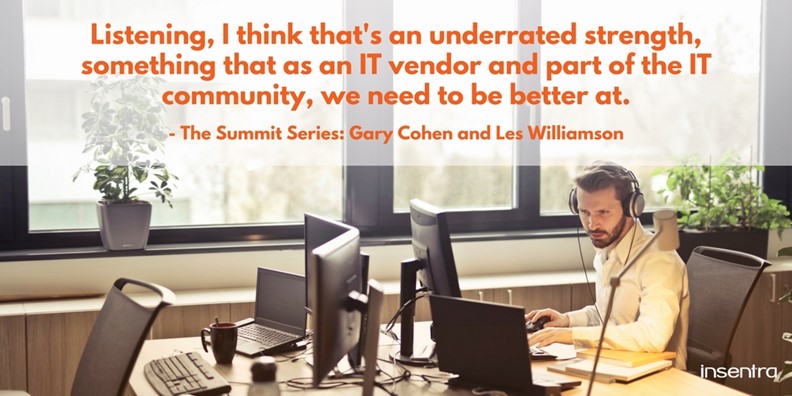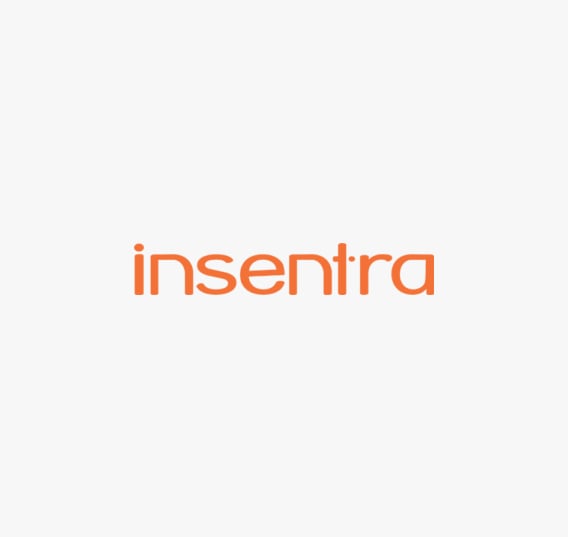In this installment of The Summit Series, Insentra’s Gary Cohen interviews Les Williamson, Managing director of Citrix Australia and New Zealand.
Les and Gary discuss the key pain points that Citrix seeks to address in Australia and New Zealand. Les reflects on the opening keynotes from Citrix Summit and what the main talking points were.
TIMELINE / KEY POINTS:
[01:48] Productivity is a big term and means lots of different things to lots of different industry sectors and customers.
[02:18] Listening, I think that’s an underrated strength, something that as an IT vendor and part of the IT community, we need to be better at.
[04:57] Where our portfolio plays a role, is that we become that aggregator, we become that front door to all the Cloud implementations that our customers have made.
[06:14] I want to treat partners as end user customers, equally as important for us to understand your outcomes, your drivers, and for us to align to that.
[06:35] Listen to our customers jointly, device valued propositions, and then let’s go in together and make it happen for our customers.


READ THE TRANSCRIPT
Gary: Good day, guys. Gary from Insentra. We’re here in the US at Citrix Summit 2018. I’m here with Les. How are you doing, Les?
Les: Good to see you, how are you?
Gary: Good, thank you. Thanks for joining us today.
Les: Thank you for being here at Citrix Summit 2018. It’s fantastic to have you here.
Gary: Absolute pleasure. Do you want to share with us your role and what you do for Citrix?
Les: Sure. I’m one year and one day in, and I’m the area vice president for Citrix in Australia and New Zealand. Basically, try and lead, and look after the business for the great islands of Australia and New Zealand.
Gary: Very good. Do you want to share with us some of the business challenges and opportunities that we face in Australia with organisations today?
Les: There are plenty there, as you know, Gary. The economy in Australia has been quite positive. I mean, we’ve had 28 consecutive quarters of GDP growth, but we’re finding from customers both big and small that productivity is one of the major issues of Australian businesses. It’s not just us hearing that, it’s not just enterprises big and small talking about it, it’s a govt and OSED recognized issue that Australia has just not been productive enough.
When you think of all the investments, not just in IT but in mgt processes systems, to have a fairly stagnant productivity level in Australian corporate life is just not good enough. We see that as one of the major challenges facing all corporations, big, small and in between.
Gary: What would Citrix be doing to try and resolve those issues, or to assist in resolving those issues today?
Les: Well, the first thing is that we’re listening to their pain points, because productivity is a big term and means lots of different things to lots of different industry sectors and customers. First and foremost, I want us to be listening to what their pain points are. That can be reflected in workforce productivity, chain productivity, a whole raft of different measures that they themselves have as a corporation. They’re the things that we need to tap into, those business outcomes, what’s not working, and also leveraging what is working to them.
First and foremost, listening. Also, ask your partners to be listeners in the first instance. I think that’s an underrated strength and something that as an IT vendor and part of the IT community, we need to be better at. To me, first and foremost, listen to our customers business outcomes, key drivers and their pain points. Then secondly, come back into your partner envt, come back into the Citrix envt, and let’s work out what aspects of our portfolio, together, can then address those pain points, can address those issues, can address those positive opportunities.
I’m pretty confident that in our portfolio, coupled with our partner’s strength, that we certainly can start to talk a value-based proposition back to them, addressing those clear business outcomes that they’ve drawn.
Gary: We’re coming to the end of day one, and this morning, first thing, we’ve had the opening keynotes, what are some of the key messages that you took from today?
Les: We did have the opening keynote. It was David’s first keynote as our new CEO. What I took away, first and foremost, was we spoke about economic factors, business outcome factors, the things I was talking about earlier. To me, that is a bit of a shift. I’ve only attended one other Summit, so I’ve only got two to compare, but I know from history that we tended to dump into the portfolio and the technology rather quickly.
Whilst we all love that, our customers are not that as interested into it as we would like them to be. What I took away was it was great to see our global CEO talking about economic conditions, business outcomes, markets and opportunities. That was my first takeaway. Second, a massive addressable market for Citrix and our partners. Globally, it was some 27 billion US dollars as an addressable market for the next couple of years.
Now, in Australia, we’ve translated that addressable market to a roundabout 700-900 million Australian dollars. Just a drop then to a local context, we see a massive addressable market just like we did globally. Second takeaway, massive untapped market opportunity for our partners and for us. Third takeaway from his keynote in particular, clearly as a focus on a couple of platform priorities, if you like, and that is the transition to Cloud.
Globally, the move to Cloud is quite new for certain countries, certain organisations. In Australia, New Zealand, we operate in a very mature– some would say cynical Cloud market, where we’re probably oversubscribed with the move to Cloud. Where our portfolio plays a role, is that we become that aggregator, we become that front door to all the Cloud implementations that our customers have made. My third takeaway is that that’s where we need to focus our portfolio attention. It’s that security to the workspace in the win, almost as an aggregator, as a front door to all our customers’ Cloud implementation.
Gary: My final question to you, 2018, figure for all of us, what would you like to see from our partners?
Les: I want to see a couple of things from our partners. First and foremost in Australia and New Zealand, very proud and happy that finally, from an internal perspective, we’ve built a high class channel team. For the first time in over thirteen, fourteen months, we now have a fully subscribed partner account team. We’ve got a new channel director and we’ve got clear focus of what we want to do with our partners. First and foremost, I think that’s a positive.
All our partners should be happy with that, in engaging with that team on a daily basis. Secondly, I want us to agree between each other a fairly clear business level what are the outcomes you’re driving as partners into the Australian ICT marketplace, and then lay down some line to those. I want to treat partners as end user customers, equally as impt for us to understand your outcomes, your drivers, and for us to align to that. That’s paramount for me, and you’ve got my commitment that that’s where the focus of the team should be.
If you’re not feeling that, please get in contact with me because that’s where we need to be. Then third and foremost, back to what I said at the start, listen to our customers jointly, device valued propositions, and then let’s go in together and make it happen for our customers.
Gary: Very good. Thank you so much for your time today.
Les: No worries, Gary. Always great to see you. I do want to thank Insentra again for your investment, coming all this way to America for Summit ’18. It’s fantastic to see you.
Gary: Thank you so much.
[music]








![TCBI-Employer-2024_Colour-small-1.png United Kingdom | Controlling New Outlook Using Intune [With a Video Tutorial]](https://www.insentragroup.com/gb/wp-content/uploads/sites/20/2024/01/TCBI-Employer-2024_Colour-small-1-208x300.png)


